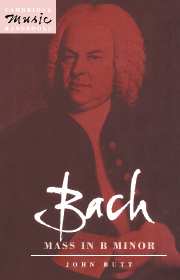Book contents
- Frontmatter
- Contents
- Preface
- List of abbreviations
- 1 The musical genre of the mass Ordinary
- 2 Genesis and purpose
- 3 Reception history
- 4 Text and music: the process of adaptation and composition
- 5 Ritornello forms
- 6 The influence of the dance
- 7 Counterpoint
- 8 Figurae and the motivic texture
- 9 Patterns and proportions: large-scale structuring and continuity in the Mass in B Minor
- Afterword
- Notes
- Select bibliography
- Index
Afterword
Published online by Cambridge University Press: 05 June 2012
- Frontmatter
- Contents
- Preface
- List of abbreviations
- 1 The musical genre of the mass Ordinary
- 2 Genesis and purpose
- 3 Reception history
- 4 Text and music: the process of adaptation and composition
- 5 Ritornello forms
- 6 The influence of the dance
- 7 Counterpoint
- 8 Figurae and the motivic texture
- 9 Patterns and proportions: large-scale structuring and continuity in the Mass in B Minor
- Afterword
- Notes
- Select bibliography
- Index
Summary
It is impossible – and undesirable – to reach a definitive interpretation of a work of the complexity and scale of Bach's Mass in B Minor. The effectiveness of this handbook can perhaps be judged only by ascertaining whether it has outlined sufficiently the historical and analytical criteria (and also the uncertainties) by which the boundaries of possible interpretation can be established. The chapters devoted to analysis of the work itself are designed to show how the piece can be studied and appreciated from different viewpoints and also on different scales and dimensions. All the approaches assess only a cross-section of the work, but together they point to the enduring quality of the music, which can be perceived at virtually every level of the composition. The very impossibility of uncovering the entire secret of the work in a single study points to the sophistication of its structure and its studied multivalency, which tease our preconceptions, perceptions and expectations.
Historically the work is an exhaustive – if not didactic – summation of the composer's musical skills, and of all the styles, idioms and devices available to his age. Bach clearly viewed the mass genre as the most historically durable form and believed the musical language of the ‘thoroughbass age’ to reflect a God-given structure and order. The concepts of hard work, thoroughness and of following an established order to its furthest implications, are evident both in the genesis of the Mass in B Minor – obviously aiming towards the perfection and unification of pre-existent material – and in the sheer density of the resulting work.
- Type
- Chapter
- Information
- Bach: Mass in B Minor , pp. 102 - 103Publisher: Cambridge University PressPrint publication year: 1991

